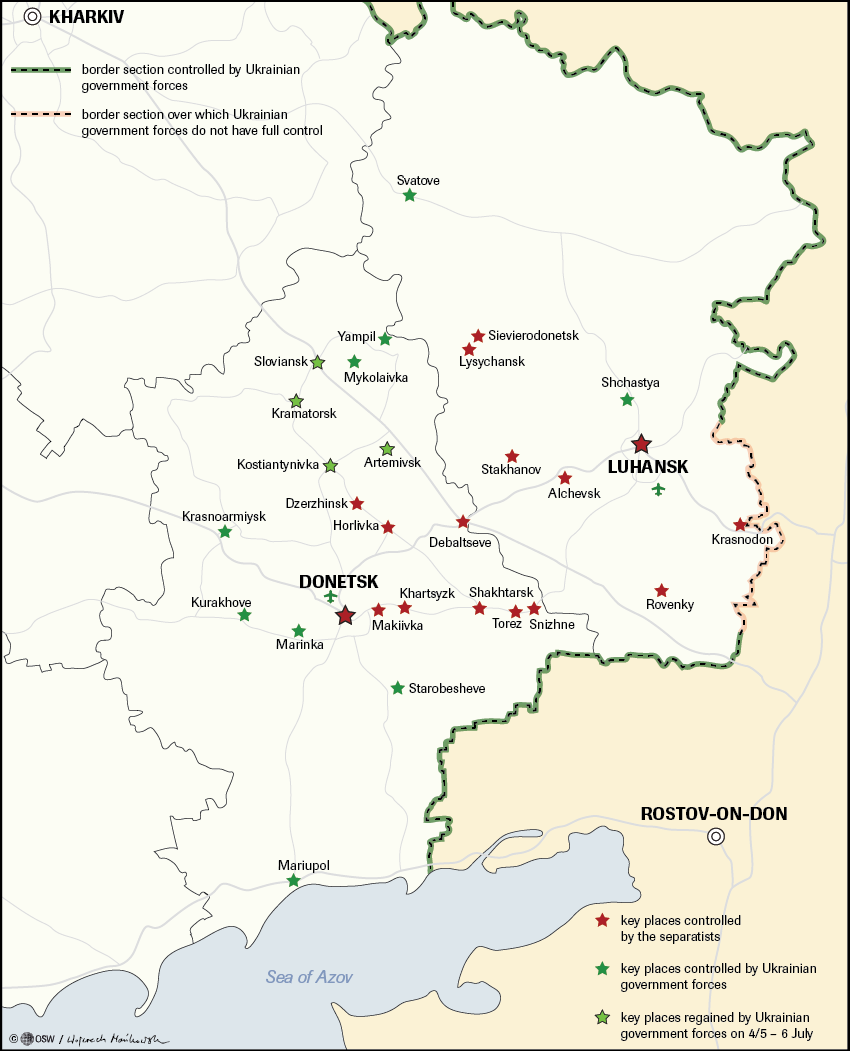The separatists are yielding to Kyiv
Between 4 and 5 July at night the eastern Ukrainian separatists withdrew from Sloviansk and Kramatorsk. They also abandoned a number of other places in the northern part of Donetsk Oblast by 6 July. Regaining control of this area is very important for Kyiv in psychological terms. The Ukrainian government forces succeeded in taking the initiative and pushing the separatists onto the back foot. The rebel forces are now unable to launch any offensive outside the areas they are controlling. They will attempt to hold their defensive positions within the triangle of the cities Donetsk-Sievierodonetsk/Lysychansk-Luhansk and at the crucial interchange in Debaltseve, which connects these cities, and to keep control of the corridors running to the Russian border. Kyiv’s recent moves are contrary to Russian expectations that a ceasefire will be announced soon in Ukraine. The lack of a firm response from Moscow may be proof of its doubts as to what tactic it should adopt with regard to the Ukrainian crisis; the dilemma being whether to continue escalating military actions or to seek political compromise.
The separatists’ manoeuvre
The separatist units which had withdrawn from Sloviansk, Kramatorsk and the other places were redeployed in Donetsk and Horlivka. The order was passed directly by Igor Girkin alias Strelkov, the commander of the separatist troops in Sloviansk and of the armed forces of the Donetsk People’s Republic (DPL). The decision was taken suddenly and the troops withdrew hastily, leaving behind a large stock of equipment and food. This manoeuvre was aimed at concentrating the dispersed forces in the region’s key city, Donetsk (Horlivka is a strategically important place as the Donetsk-Luhansk route can be controlled from there). The separatists were forced into making this manoeuvre by the Ukrainian government troops. The Ukrainian side concentrated strong forces, which had not been engaged in fighting before, around Sloviansk, and thus gained the military advantage. The withdrawn separatist troops were tired and had problems with maintaining uninterrupted supplies (there was concern that as a consequence of intensified action from the Ukrainian government forces that supplies would be cut off). By moving their main forces to Donetsk, the leaders of the DPL intended also to strengthen their grip on all separatist units, which gave rise to the recent conflicts between individual commanders (for example, two competitive rebel groups were seen exchanging fire in Donetsk on 2 July). Last but not least, this decision was an indirect effect of the deteriorating humanitarian situation in Sloviansk and Kramatorsk. The water, electricity and food shortages could aggravate the local residents’ negative sentiments towards the separatists.
Ukraine is taking the initiative
Regaining control over Sloviansk and the places around it was the first major success of the Ukrainian government forces since winning back Mariupol on 13 June. This success is even more meaningful, given the fact that on 12 April Sloviansk and Kramatorsk became the first cities to be seized by the separatists. Control of these cities had great symbolic meaning: the top leaders of the DPL had their headquarters there, and the separatists launched their raids on the neighbouring Kharkiv Oblast from there. By regaining this area, the Ukrainian side took the initiative from the separatists and pushed them onto the defensive. The commanders of the antiterrorist operation have announced that actions aimed at blocking Donetsk and Luhansk and at regaining control over the entire Ukrainian-Russian border (its section in Luhansk Oblast is not under full control as yet) and thus forcing the rebels to capitulate. At the same time, the government has emphasised that those who submit voluntarily (and who are not responsible for egregious crimes) will be covered by an amnesty.
It is worth noting that it is only since Petro Poroshenko was elected president that the coordination and effectiveness of actions taken as part of the antiterrorist operation have improved. The verification of the Ukrainian military and intelligence staff has also contributed to this. One change is that at present regular army troops form the core of the operation, whereas previously volunteer troops of the National Guard and other informal formations, whose level of training was lower, were more strongly engaged. Whether this success will last depends very much on how soon the government in Kyiv will be able to bring back normal life to the regained cities, i.e. ensure water and electricity supplies, rebuild infrastructure and counteract sabotage actions staged by the separatists. For the time being, it is making attempts at launching humanitarian aid. It has also unblocked the payment of pensions.
The military success has also strengthened Kyiv’s position in political negotiations. For this reason the meeting of the contact group which had been scheduled for 5 July did not take place (talks between the representatives of Ukraine, Russia and the OSCE on 6 July in Kyiv brought no results).
Moscow’s unclear stance
The fact that the separatists have been pushed out of Sloviansk has seriously undermined the tactic Russia had employed thus far because the pro-Russian groupings have sustained great losses. The Russian government was hoping that a scenario would be implemented which would include the agreement reached on 3 July in Berlin by the ministers of foreign affairs of Ukraine, Russia and Germany as a consequence of pressure from Moscow. According to this agreement, an unconditional and durable ceasefire was to be announced in eastern Ukraine soon, not later than by 5 July, and which would be monitored by the OSCE. The ceasefire was to be prepared by a contact group, members of which included representatives of Ukraine, the OSCE and the separatists, and also the Russian ambassador and Viktor Medvedchuk. The agreement was to prevent Kyiv from counteracting the separatists’ position in eastern Ukraine being entrenched and to force Kyiv to negotiate the conditions of the conflict resolution with the separatists. Issues concerning the political system of the entire country would be among these conditions; and this would have enabled Moscow to have constant influence on the situation in Ukraine and on Ukraine’s geopolitical orientation. The Russian minister of foreign affairs, Sergey Lavrov, in his comment on the recent developments in Ukraine on 7 July upheld the previous Russian stance and appealed for a ceasefire to be announced immediately and for talks to be commenced as part of the contact group.
It is worth noting that there was no firm reaction from Moscow to the way events have turned in Ukraine and thwarted its efforts. At the same time, attempts to dissociate Russia from actions taken by the separatists have been heard in the Russian media and statements from pro-Kremlin experts. They are especially critical of the rebel leader in Sloviansk, Igor Girkin (Strelkov). This can be viewed as a sign of discord among the elite in the Kremlin over the tactic it should adopt from now on with regard to Ukraine and also of emerging doubts as to whether a continuation of this conflict makes sense. Given the present facts, it cannot be ruled out that the Kremlin now might be interested in searching for a solution to this situation which is based more on compromise.
The military consequences
The fact that Kyiv has regained control of Sloviansk and the places around it does not mean that defeat of the rebels or the full success of the antiterrorist operation are a foregone conclusion. In this new military situation, the separatists’ tactic is focused on defending their positions in the key cities of the region: Donetsk, Luhansk and Sievierodonetsk/Lysychansk and keeping control of the transport routes between them (the Donetsk-Luhansk road and the interchange in Debaltseve are strategically important) and also of the routes which lead to the Russian border. They will also take action to make it more difficult for Ukrainian troops to move across eastern Ukraine (for example, a bridge in Novobakhmutovka was blown up on 7 July, thus blocking the road running from Kramatorsk to Donetsk). They will not be able to regain the initiative and launch offensive actions to increase the areas controlled by them without strong support from Russia (including militants). Although it seems now that Russia does not intend to launch a military intervention in Ukraine (for example, by sending its peacekeeping forces), it is still too early to rule out this scenario.
The political consequences
The lack of a clear reaction from Russia to the present situation in Ukraine indicates that Russian decision-makers are beginning to have doubts about the tactic of conflict escalation which has been in use in Ukraine thus far. It seems that Russian actions may now be more focused on achieving beneficial solutions through political negotiations. The fact that the separatists control the capital cities of the two oblasts is to be used as the key argument to open political negotiations with the separatists and to make it possible to force the Ukrainian government and also the EU and the United States to accept an agreement which would de facto guarantee Donbas’s independence from Kyiv. However, given the military defeats of the rebels and deepening divides between them, Kyiv’s position in political negotiations is becoming ever stronger.
Map
Situation in eastern Ukraine (as of 9 July, 12 noon)





